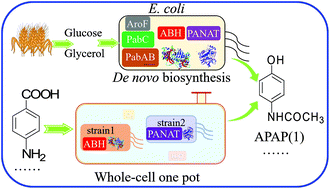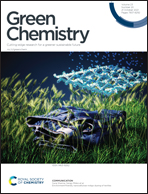De novo biosynthesis and whole-cell catalytic production of paracetamol on a gram scale in Escherichia coli†
Abstract
The synthetic drug paracetamol is one of the most commonly used analgesic, antipyretic agents around the world. Global massive demand promoted its synthesis in large quantities. Chemical synthesis is the main approach for paracetamol production. However, the reaction process contributes toward environmental pollution, and the reaction conditions are harsh. Herein, we reported the construction of the paracetamol de novo biosynthetic pathway in Escherichia coli. Five enzymes from different microbial sources were heterologously expressed into E. coli to construct the APAP (1) producing strain PA1. Through protein engineering of ABH (4-aminobenzoate hydroxylase) and PANAT (arylamine N-acetyltransferase), enhancement of the host cell resistance to the substrate or final product, and utilizing synthetic protein scaffolds to optimize the metabolic flux, the engineered strain could produce 942.5 mg L−1 (6.24 mM) paracetamol in a fed-batch 5 L fermenter directly from glucose or glycerol, which circumvents the fossil fuel resource use. Moreover, we established a whole-cell cascade biocatalytic synthesis way to paracetamol and analogues. Using p-aminobenzoate as the substrate, 4.2 g L−1 (27.7 mM) paracetamol can be formed after 9 h (95% conversion rate). After metabolic engineering, enzyme molecular modification, and other optimizations, we created the biotransformation strategy to manufacture paracetamol on a gram scale. This study provides a promising green and efficient alternative to the traditional chemical manufacturing method.



 Please wait while we load your content...
Please wait while we load your content...